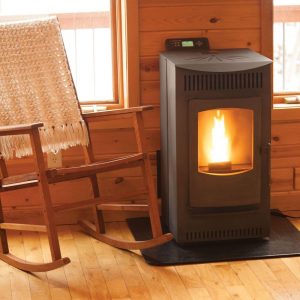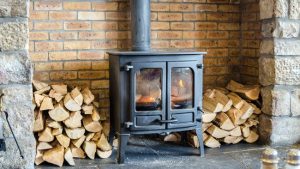Lets face it, heat is expensive. Especially in the dead of winter. When the temperatures fall in the single digits, sadly the heat bill can go into the triple digits. Whether you heat your home with gas or oil the high prices during the winter sky rocket.
Many people have turned to heat there home with alternative heat sources. These are a great way to warm a room and even an entire house. With that being said, there are many dangers with doing this. Now its not all bad, of course when you do it properly its a great heat source. Here are some great safety tips-
Pellet Stoves
A pellet stove is a stove that burns wood or pellets to create a source of heat for your home. Wood pellet stoves are generally small, and the bags of pellets are about the  size of a mulch bag, making them easy to store. They’re also easy to operate; they only require loading pellets and igniting the flame. And depending on what size hopper your stove has, it may need to be loaded only once a day.
size of a mulch bag, making them easy to store. They’re also easy to operate; they only require loading pellets and igniting the flame. And depending on what size hopper your stove has, it may need to be loaded only once a day.
Because the fire is contained in a heat box inside the unit, there is a minimum of smoke, which lessens the smell in your home and prevents the outside of the unit from heating up. Pellets create considerably less ash than firewood, giving off less creosote, a flammable byproduct of combustion that can build up and cause chimney fires.
Follow these simples rules from disatersafety.org when using your pellet stove:
- Always hire an installer who is licensed and certified.
- Stove placement must allow for access to proper venting and electrical sources and must meet minimum required clearances. Certified installers operate according to these guidelines.
- Outlets must be checked for proper voltage, grounding and polarity.
- According to model building codes, multiple walled insulated forced-air stoves within compartments or alcoves should have a minimum of 3 inches of working space clearance along the sides, back and top with a total width of the enclosing space being at least 12 inches wider than the stove.
- Stoves having a firebox open to the atmosphere should have at least a 6-inch working space along the front combustion chamber side.
- Keep the stove clear of all combustible materials.
- Use PL vent pipes tested to UL 641.
The following materials should never be used to vent pellet appliances:
- Dryer vent
- Gas appliance Type B vent
- PVC pipe
- Single-wall stove pipe, unless approved by local codes and the installation manual
- Inspect chimney before installation. Relining may be required.
- Altitudes higher than 2,500 feet may require special venting options.
- An outside air source may be required for houses with tight construction or strong kitchen, bath or other exhaust fans.
- Manufacturer’s instructions must be closely followed regarding sealing joints and seams, particularly of pressurized mechanical exhaust vents.
- Regular maintenance is critical to ensure safe operation.
- Frequency of cleaning will depend on the fuel type, grade and content.
- Components should be inspected daily.
- Professional cleaning is recommended for vent systems before each seasonal use.
Wood Stoves
More than 12 million households in the United States rely on wood-burning stoves to generate heat, reports the U.S. Environmental Protection Agency. Modern wood stoves offer the warmth and beauty of a roaring fire without the pollution associated  with the traditional wood-burning fireplace.
with the traditional wood-burning fireplace.
As a wood stove heats up, it radiates heat through the walls and top of the stove. This radiant heat warms the immediate area and can be carried into other parts of the home via the home’s natural air flow. Electric or convection-powered fans can help circulate this heat to warm a larger area. Some wood stoves combine radiant and convection heat into a single device using a convection chamber, which wraps around the firebox. This convection chamber draws cool air in, then warms it before circulating it back through the room.
Follow these simple rules before heating your home with a wood stove from disastersafety.org:
- Choose a stove that has been tested by UL.
- Second-hand stoves should be free of broken parts or cracks.
- Maintain at least a 36-inch clearance between the stove and combustible materials or use fire-resistant materials to protect woodwork and other areas. Follow manufacturer’s guidelines.
- Keep the stove clear of combustible materials.
- Noncombustible floor covering should be used under and around the stove. The material should extend 18 inches on all sides.
- Prior to using the stove, place a layer of sand or firebrick in the bottom of the firebox.
- Vent pipes or chimneys must be inspected prior to use.
- If a stove pipe is used:
- Use 22- or 24-gauge metal with a total length of less than 10 feet.
- Maintain at least 18 inches between the top of the stove pipe and the ceiling or other combustible material.
- Ensure that the stove pipe enters the chimney at a spot higher than the outlet of the stove firebox and that it does not extend into the chimney flue lining.
- The inside thimble diameter should be the same size as the stove pipe for a proper seal.
- The stove pipe should not pass through a floor, closet or concealed space, or enter the chimney in the attic.
- If a metal chimney is used, make sure it is UL-approved.
Whether masonry or metal, the chimney should extend:
- At least 3 feet above the highest point where it passes through the roof, and
- At least 2 feet above any portion of the building within 10 horizontal feet of the chimney.
The chimney flue lining should not be blocked.
- Keep the chimney flue and stove pipe clean and free of obstructions.
Space Heaters
Space heaters are a great way to heat a room at a very affordable price. They do not need to be installed, rather plugged in. Though they can not heat an entire home or floor they are really good for small areas.
Safety should always be a top consideration when using space heaters. Here are some tips for keeping your home safe and warm when it’s cold outside from esfi.org :
- Make sure your space heater has the label showing that it is listed by a recognized testing laboratory.
- Before using any space heater, read the manufacturer’s instructions and warning labels carefully.
- Inspect heaters for cracked or broken plugs or loose connections before each use. If frayed, worn or damaged, do not use the heater.
- Never leave a space heater unattended. Turn it off when you’re leaving a room or going to sleep, and don’t let pets or children play too close to a space heater.
- Space heaters are only meant to provide supplemental heat and should never be used to warm bedding, cook food, dry clothing or thaw pipes.
- Install smoke alarms on every floor of your home and outside all sleeping areas and test them once a month.
- Proper placement of space heaters is critical. Heaters must be kept at least three feet away from anything that can burn, including papers, clothing and rugs.
- Locate space heaters out of high traffic areas and doorways where they may pose a tripping hazard.
- Plug space heaters directly into a wall outlet. Do not use an extension cord or power strip, which could overheat and result in a fire. Do not plug any other electrical devices into the same outlet as the heater.
- Place space heaters on level, flat surfaces. Never place heaters on cabinets, tables, furniture, or carpet, which can overheat and start a fire.
- Always unplug and safely store the heater when it is not in use.
